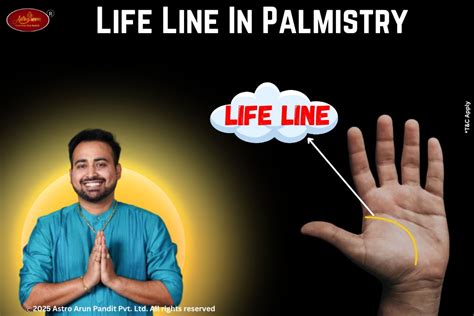The life line, a pivotal component of palmistry, has captivated human curiosity for centuries. This intricate line, which begins between the thumb and index finger and arcs downward toward the wrist, is believed to reveal profound insights into an individual’s life journey, including their physical and emotional well-being, major life events, and even their destiny. To delve into the mysteries of the life line and uncover the secrets it holds, we must first understand the fundamental principles of palmistry and the role this line plays in the grand tapestry of an individual’s palm.
Palmistry, an ancient practice with roots in Indian, Chinese, and Greek cultures, is based on the premise that the lines, mounts, and patterns on an individual’s palms contain encoded information about their personality, strengths, weaknesses, and potential. The life line, being one of the most prominent and easily identifiable features on the palm, is often the first aspect examined in a palm reading. Its length, depth, curvature, and any branching or intersecting lines all contribute to a nuanced understanding of an individual’s life path.
One of the primary ways the life line is interpreted is through its length. A longer life line is generally associated with a longer, healthier life, while a shorter line may indicate a shorter lifespan or significant health challenges. However, the length of the life line alone is not definitive; its depth and clarity are also crucial. A deep, well-defined line suggests vitality and resilience, whereas a faint or fragmented line may indicate periods of weakness or illness.
The curvature of the life line also holds significant meaning. A life line that curves closer to the thumb is believed to indicate a more emotional and sensitive nature, while a line that curves toward the edge of the palm may signify independence and a stronger connection to logic and reason. Additionally, the presence of any breaks, branches, or islands along the life line can signify major life events, such as significant relationships, career changes, or health crises. For instance, a branch that extends toward the mounts of Jupiter or Apollo can indicate personal and professional success, while an island may suggest a period of confusion or stagnation.
To decipher the life line accurately, palmists also consider its interactions with other lines and features on the palm. The relationship between the life line and the heart line, for example, can provide insights into how an individual’s emotional life influences their overall well-being. Similarly, the connection between the life line and the fate line (or destiny line) can reveal how an individual’s life journey aligns with their career path and long-term goals.
The fate line, which often intersects with the life line, is particularly interesting when discussing destiny. This line, which rises from the base of the palm and extends toward the middle finger, is thought to signify an individual’s career path, life purpose, and the degree to which they are living in alignment with their higher calling. When the life line and fate line intersect, it can indicate a moment of significant decision or a turning point in one’s career or life direction.
Decoding the life line also involves understanding its role in reflecting an individual’s inner world. The life line can indicate periods of emotional turmoil or stability, revealing patterns and tendencies that may influence an individual’s relationships and overall happiness. For instance, a life line with many branches may suggest a dynamic, eventful life with multiple interests and relationships, while a simpler line may indicate a more straightforward, perhaps less complicated, life path.
Despite its name, the life line does not predict the literal length of one’s life but rather offers a symbolic representation of an individual’s life force, vitality, and spiritual connection. It serves as a map, guiding individuals toward a deeper understanding of themselves and their place in the world. By examining the life line in the context of the entire palm, individuals can gain profound insights into their strengths, challenges, and life’s purpose, ultimately empowering them to make informed decisions that align with their highest potential.
In conclusion, the life line on the palm is a complex and multifaceted feature that holds the key to understanding an individual’s life journey, challenges, and potential. By considering its length, depth, curvature, and interactions with other lines and features, palmists can provide a nuanced and detailed analysis of an individual’s life path and destiny. Whether viewed as a tool for personal growth, a means of understanding life’s complexities, or simply as a fascinating aspect of human anatomy, the life line remains an intriguing and enlightening subject of study.
What does the life line in palmistry signify?
+The life line in palmistry is believed to signify an individual’s physical and emotional well-being, major life events, and overall life journey. It is not a direct indicator of lifespan but rather a symbolic representation of life force and vitality.
How is the length of the life line interpreted?
+A longer life line is generally associated with a longer, healthier life, while a shorter line may indicate a shorter lifespan or significant health challenges. However, interpretation also considers the line’s depth and clarity, as well as its overall shape and any branches or breaks.
Can the life line predict destiny or future events?
+The life line, in conjunction with other features on the palm, can provide insights into an individual’s life path and potential future events. It is not a predictor of absolute destiny but rather a tool that can offer guidance on life’s journey and help individuals understand their strengths, weaknesses, and potential.
How does the life line interact with other lines on the palm?
+The life line’s interaction with other lines, such as the heart line and the fate line, can provide detailed insights into an individual’s emotional life, career path, and overall alignment with their life purpose. These interactions are crucial for a comprehensive palm reading.
Can the life line change over time?
+Yes, the life line can change over time, reflecting significant life events, personal growth, or changes in health and well-being. These changes can be seen as adaptations or evolutions in an individual’s life journey, offering new insights into their path forward.
What is the significance of branches or breaks in the life line?
+Branches or breaks in the life line can signify major life events, such as significant relationships, career changes, health crises, or periods of personal transformation. These markers can provide valuable insights into an individual’s past, present, and potential future, helping them understand the complexities of their life journey.



